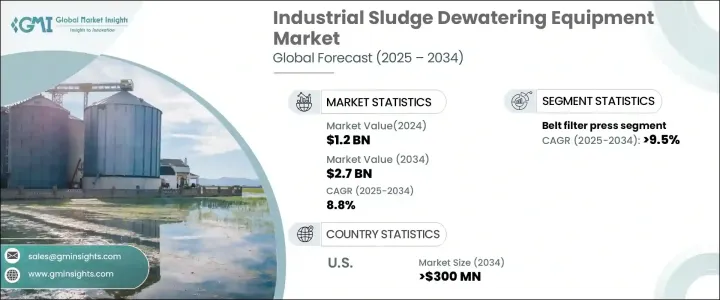
세계 산업용 슬러지 탈수 장비 시장은 2024년에 12억 달러로 평가되었으며, 급속한 산업화와 효율적인 폐수 관리 솔루션에 대한 요구가 높아짐에 따라 2025년부터 2034년에 걸쳐 8.8%의 연평균 복합 성장률(CAGR)로 견고하게 성장할 것으로 예측되고 있습니다.
이러한 급성장은 비즈니스 효율성을 최적화하면서 엄격한 환경 규제를 준수하기 위해 고급 탈수 기술을 도입하는 기업에 의해 촉진되고 있습니다. 지속 가능한 폐기물 관리 기법에 대한 관심 증가는 슬러지 양 감소, 귀중한 자원 회수, 폐기 비용 최소화를 목표로 하는 기업의 혁신을 뒷받침하고 있습니다.

모듈식으로 확장 가능한 슬러지 탈수 시스템에 대한 수요가 증가함에 따라 이 시장은 2034년까지 27억 달러를 창출할 것으로 예상됩니다. 각 업계의 기업들은 매립지에 대한 의존도 저하와 상당한 비용 절감 등 효과적인 슬러지 관리가 가져오는 경제적 및 환경적 이점을 실감하고 있습니다. 또한 영양염 추출과 바이오가스 생성 등 자원 회수 기술의 통합이 인기를 끌고 있습니다. 기업은 지속가능성 이니셔티브에 따라 규제 준수를 강화하고 전반적인 수익성을 향상시키는 솔루션을 선호합니다.
| 시장 범위 | |
|---|---|
| 시작 연도 | 2024년 |
| 예측 연도 | 2025-2034년 |
| 시작 금액 | 12억 달러 |
| 예측 금액 | 27억 달러 |
| CAGR | 8.8% |
환경에 미치는 영향을 줄이는 것이 중요해졌고, 산업계는 최첨단 탈수 기술을 채택하게 되었습니다. 기존의 슬러지 처리 방법은 제한된 매립지와 급등하는 처리 비용으로 인해 시대에 뒤처지고 있습니다. 기업은 현재 더 나은 슬러지 처리 및 자원 최적화를 가능하게 하는 고효율 탈수 솔루션에 투자하고 있습니다. 세계적으로 정부 규제가 계속 강화되고 있기 때문에 산업계는 비용 효율성을 유지하면서 컴플라이언스를 보장하는 혁신적인 전략을 채택해야 합니다. 시장은 자동화와 스마트 모니터링으로의 전환을 목격하고 탈수 공정의 효율성을 더욱 향상시키고 있습니다.
산업 슬러지의 탈수에 사용되는 다양한 기술 중에서 벨트 필터 프레스 분야는 2034년까지 연평균 복합 성장률(CAGR) 9.5%를 나타낼 것으로 예측됩니다. 이 기술은 두드러진 기계적 탈수 능력으로 인해 슬러지 처리 비용을 크게 줄일 수 있습니다. 일련의 롤러를 사용함으로써 벨트 필터 프레스는 물 추출을 최적화하고 슬러지의 일관성을 향상시킵니다. 그 효과로 인해 진화하는 폐수 처리 기준을 준수하는 산업에 선호되는 옵션이되었습니다. 산업 폐기물 처리에 관한 규제의 엄격화와 매립지의 축소에 의해 벨트 필터 프레스 기술에 대한 수요가 계속 증가하고 있습니다.
미국 산업용 슬러지 탈수 장비 시장은 주요 산업에서 효과적인 슬러지 관리 솔루션의 긴급 요구에 따라 2034년까지 3억 달러를 창출할 것으로 예측됩니다. 대량의 슬러지를 효율적으로 처리하기 위해 원심분리기나 스크류 프레스 등의 고급 탈수 기술을 도입하는 기업이 늘고 있습니다. 환경의 지속가능성에 대한 의식이 증가하고 정부 규제가 강화됨에 따라 산업계는 혁신적인 탈수 방법으로의 전환을 빠르게 진행하고 있습니다. 지속 가능한 사업 운영을 목표로 하는 움직임은 최첨단 슬러지 처리 솔루션의 채택에 박차를 가해 장기적인 컴플라이언스와 비용 절감을 전국의 기업에 보증하고 있습니다.
The Global Industrial Sludge Dewatering Equipment Market, valued at USD 1.2 billion in 2024, is projected to grow at a robust CAGR of 8.8% between 2025 and 2034, driven by rapid industrialization and the increasing need for efficient wastewater management solutions. This surge is fueled by businesses implementing advanced dewatering technologies to comply with stringent environmental regulations while optimizing operational efficiency. The growing focus on sustainable waste management practices is pushing companies to innovate, aiming to reduce sludge volume, recover valuable resources, and minimize disposal costs.

With an increasing demand for modular and scalable sludge dewatering systems, the market is expected to generate USD 2.7 billion by 2034. Companies across industries are realizing the financial and environmental benefits of effective sludge management, including lower landfill dependency and substantial cost reductions. Additionally, integrating resource recovery technologies, such as nutrient extraction and biogas generation, is gaining traction. Businesses are prioritizing solutions that align with sustainability initiatives, enhance regulatory compliance, and improve overall profitability.
| Market Scope | |
|---|---|
| Start Year | 2024 |
| Forecast Year | 2025-2034 |
| Start Value | $1.2 Billion |
| Forecast Value | $2.7 Billion |
| CAGR | 8.8% |
A strong emphasis on reducing environmental impact has led industries to adopt cutting-edge dewatering technologies. Traditional sludge disposal methods are becoming obsolete due to limited landfill space and escalating disposal costs. Companies are now investing in high-efficiency dewatering solutions that enable better sludge handling and resource optimization. Government regulations worldwide continue to tighten, compelling industries to adopt innovative strategies that ensure compliance while maintaining cost-effectiveness. The market is witnessing a shift toward automation and smart monitoring, further enhancing the efficiency of dewatering processes.
Among the various technologies used in industrial sludge dewatering, the belt filter press segment is set to grow at a CAGR of 9.5% through 2034. This technology stands out due to its superior mechanical dewatering capabilities, which significantly lower sludge disposal costs. By utilizing a series of rollers, belt filter presses optimize water extraction and improve sludge consistency. Their effectiveness makes them a preferred choice for industries aiming to comply with evolving wastewater treatment standards. Heightened regulatory scrutiny over industrial waste disposal and the shrinking availability of landfill space continues to drive the demand for belt filter press technology.
The U.S. industrial sludge dewatering equipment market is forecast to generate USD 300 million by 2034, driven by the urgent need for effective sludge management solutions across key industries. Businesses are increasingly deploying advanced dewatering technologies, such as centrifuges and screw presses, to handle large volumes of sludge efficiently. With growing awareness of environmental sustainability and stricter government regulations, industries are rapidly transitioning to innovative dewatering methods. The push toward sustainable operations is fueling the adoption of cutting-edge sludge treatment solutions, ensuring long-term compliance and cost savings for businesses nationwide.